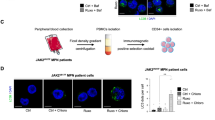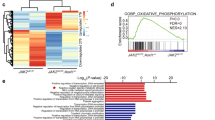Summary
JAK2V617F can mimic growth factor signaling, leading to PI3K/AKT/mTOR activation and inhibition of autophagy. We hypothesized that selective inhibition of JAK1/2 by ruxolitinib could induce autophagy and limit drug efficacy in myeloproliferative neoplasms (MPN). Therefore, we investigated the effects of ruxolitinib treatment on autophagy-related genes and cellular processes, to determine the potential benefit of autophagy inhibitors plus ruxolitinib in JAK2V617F cells, and to verify the frequency and clinical impact of autophagy-related gene mutations in patients with MPNs. In SET2 JAK2V617F cells, ruxolitinib treatment induced autophagy and modulated 26 out of 79 autophagy-related genes. Ruxolitinib treatment reduced the expressions of important autophagy regulators, including mTOR/p70S6K/4EBP1 and the STAT/BCL2 axis, in a dose- and time-dependent manner. Pharmacological inhibition of autophagy was able to significantly suppress ruxolitinib-induced autophagy and increased ruxolitinib-induced apoptosis. Mutations in autophagy-related genes were found in 15.5% of MPN patients and were associated with increased age and a trend towards worse survival. In conclusion, ruxolitinib induces autophagy in JAK2V617F cells, potentially by modulation of mTOR-, STAT- and BCL2-mediated signaling. This may lead to inhibition of apoptosis. Our results suggest that the combination of ruxolitinib with pharmacological inhibitors of autophagy, such as chloroquine, may be a promising strategy to treat patients with JAK2V617F-mutated MPNs.






Similar content being viewed by others
References
Helgason GV, Karvela M, Holyoake TL (2011) Kill one bird with two stones: potential efficacy of BCR-ABL and autophagy inhibition in CML. Blood 118:2035–2043
Galluzzi L, Pietrocola F, Bravo-San Pedro JM, Amaravadi RK, Baehrecke EH, Cecconi F, Codogno P, Debnath J, Gewirtz DA, Karantza V et al (2015) Autophagy in malignant transformation and cancer progression. EMBO J 34:856–880
Bellodi C, Lidonnici MR, Hamilton A, Helgason GV, Soliera AR, Ronchetti M, Galavotti S, Young KW, Selmi T, Yacobi R et al (2009) Targeting autophagy potentiates tyrosine kinase inhibitor-induced cell death in Philadelphia chromosome-positive cells, including primary CML stem cells. J Clin Invest 119:1109–1123
Thoennissen NH, Krug UO, Lee DH, Kawamata N, Iwanski GB, Lasho T, Weiss T, Nowak D, Koren-Michowitz M, Kato M et al (2010) Prevalence and prognostic impact of allelic imbalances associated with leukemic transformation of Philadelphia chromosome-negative myeloproliferative neoplasms. Blood 115:2882–2890
Visconte V, Przychodzen B, Han Y, Nawrocki ST, Thota S, Kelly KR, Patel BJ, Hirsch C, Advani AS, Carraway HE et al (2017) Complete mutational spectrum of the autophagy interactome: a novel class of tumor suppressor genes in myeloid neoplasms. Leukemia 31:505–510
Pardanani A, Vannucchi AM, Passamonti F, Cervantes F, Barbui T, Tefferi A (2011) JAK inhibitor therapy for myelofibrosis: critical assessment of value and limitations. Leukemia 25:218–225
Harrison C, Kiladjian JJ, Al-Ali HK, Gisslinger H, Waltzman R, Stalbovskaya V, McQuitty M, Hunter DS, Levy R, Knoops L et al (2012) JAK inhibition with ruxolitinib versus best available therapy for myelofibrosis. N Engl J Med 366:787–798
Verstovsek S, Mesa RA, Gotlib J, Levy RS, Gupta V, DiPersio JF, Catalano JV, Deininger M, Miller C, Silver RT et al (2012) A double-blind, placebo-controlled trial of ruxolitinib for myelofibrosis. N Engl J Med 366:799–807
Vannucchi AM, Kiladjian JJ, Griesshammer M, Masszi T, Durrant S, Passamonti F, Harrison CN, Pane F, Zachee P, Mesa R et al (2015) Ruxolitinib versus standard therapy for the treatment of polycythemia vera. N Engl J Med 372:426–435
Meyer SC, Keller MD, Chiu S, Koppikar P, Guryanova OA, Rapaport F, Xu K, Manova K, Pankov D, O'Reilly RJ et al (2015) CHZ868, a Type II JAK2 inhibitor, reverses Type I JAK inhibitor persistence and demonstrates efficacy in myeloproliferative neoplasms. Cancer Cell 28:15–28
Thome MP, Filippi-Chiela EC, Villodre ES, Migliavaca CB, Onzi GR, Felipe KB, Lenz G (2016) Ratiometric analysis of Acridine Orange staining in the study of acidic organelles and autophagy. J Cell Sci 129:4622–4632
Reynolds ES (1963) The use of lead citrate at high pH as an electron-opaque stain in electron microscopy. J Cell Biol 17:208–212
Thiele J, Kvasnicka HM, Orazi A, Gianelli U, Barbui T, Barosi G, Tefferi A (2017) Primary myelofibrosis. In: Swerdlow SH, Campo E, Harris NL, Jaffe ES, Pileri SA, Stein H, Arber DA, Hasserjian RP, Beau MML, Orazi A, Siebert R (eds) WHO classification of tumors of haematopoietic and lymphoid tissues. IARC, Lyon, pp 44–50
Passamonti F, Cervantes F, Vannucchi AM, Morra E, Rumi E, Pereira A, Guglielmelli P, Pungolino E, Caramella M, Maffioli M et al (2010) A dynamic prognostic model to predict survival in primary myelofibrosis: a study by the IWG-MRT (International Working Group for Myeloproliferative Neoplasms Research and Treatment). Blood 115:1703–1708
Li H, Durbin R (2009) Fast and accurate short read alignment with Burrows-Wheeler transform. Bioinformatics 25:1754–1760
MA DP, Banks E, Poplin R, Garimella KV, Maguire JR, Hartl C, Philippakis AA, del Angel G, Rivas MA, Hanna M et al (2011) A framework for variation discovery and genotyping using next-generation DNA sequencing data. Nat Genet 43:491–498
Ye K, Schulz MH, Long Q, Apweiler R, Ning Z (2009) Pindel: a pattern growth approach to detect break points of large deletions and medium sized insertions from paired-end short reads. Bioinformatics 25:2865–2871
Larson DE, Harris CC, Chen K, Koboldt DC, Abbott TE, Dooling DJ, Ley TJ, Mardis ER, Wilson RK, Ding L (2012) SomaticSniper: identification of somatic point mutations in whole genome sequencing data. Bioinformatics 28:311–317
Cibulskis K, Lawrence MS, Carter SL, Sivachenko A, Jaffe D, Sougnez C, Gabriel S, Meyerson M, Lander ES, Getz G (2013) Sensitive detection of somatic point mutations in impure and heterogeneous cancer samples. Nat Biotechnol 31:213–219
Wang K, Li M, Hakonarson H (2010) ANNOVAR: functional annotation of genetic variants from high-throughput sequencing data. Nucleic Acids Res 38:e164
Genomes Project C, Auton A, Brooks LD, Durbin RM, Garrison EP, Kang HM, Korbel JO, Marchini JL, McCarthy S, McVean GA et al (2015) A global reference for human genetic variation. Nature 526:68–74
Sherry ST, Ward MH, Kholodov M, Baker J, Phan L, Smigielski EM, Sirotkin K (2001) dbSNP: the NCBI database of genetic variation. Nucleic Acids Res 29:308–311
Li G, Miskimen KL, Wang Z, Xie XY, Brenzovich J, Ryan JJ, Tse W, Moriggl R, Bunting KD (2010) STAT5 requires the N-domain for suppression of miR15/16, induction of bcl-2, and survival signaling in myeloproliferative disease. Blood 115:1416–1424
Sepulveda P, Encabo A, Carbonell-Uberos F, Minana MD (2007) BCL-2 expression is mainly regulated by JAK/STAT3 pathway in human CD34+ hematopoietic cells. Cell Death Differ 14:378–380
Guo J, Roberts L, Chen Z, Merta PJ, Glaser KB, Shah OJ (2015) JAK2V617F drives Mcl-1 expression and sensitizes hematologic cell lines to dual inhibition of JAK2 and Bcl-xL. PLoS One 10:e0114363
Miao LJ, Huang FX, Sun ZT, Zhang RX, Huang SF, Wang J (2014) Stat3 inhibits Beclin 1 expression through recruitment of HDAC3 in nonsmall cell lung cancer cells. Tumour Biol 35:7097–7103
Laplante M, Sabatini DM (2012) mTOR signaling in growth control and disease. Cell 149:274–293
Mizushima N, Yoshimori T (2007) How to interpret LC3 immunoblotting. Autophagy 3:542–545
Green DR, Galluzzi L, Kroemer G (2011) Mitochondria and the autophagy-inflammation-cell death axis in organismal aging. Science 333:1109–1112
Takahashi Y, Hori T, Cooper TK, Liao J, Desai N, Serfass JM, Young MM, Park S, Izu Y, Wang HG (2013) Bif-1 haploinsufficiency promotes chromosomal instability and accelerates Myc-driven lymphomagenesis via suppression of mitophagy. Blood 121:1622–1632
Okamoto K (2014) Organellophagy: eliminating cellular building blocks via selective autophagy. J Cell Biol 205:435–445
Can G, Ekiz HA, Baran Y (2011) Imatinib induces autophagy through BECLIN-1 and ATG5 genes in chronic myeloid leukemia cells. Hematology 16:95–99
Bagca BG, Ozalp O, Kurt CC, Mutlu Z, Saydam G, Gunduz C, Avci CB (2016) Ruxolitinib induces autophagy in chronic myeloid leukemia cells. Tumour Biol 37:1573–1579
Ianniciello A, Dumas PY, Drullion C, Guitart A, Villacreces A, Peytour Y, Chevaleyre J, Brunet de la Grange P, Vigon I, Desplat V et al (2017) Chronic myeloid leukemia progenitor cells require autophagy when leaving hypoxia-induced quiescence. Oncotarget 8:96984–96992
Seglen PO, Gordon PB (1982) 3-Methyladenine: specific inhibitor of autophagic/lysosomal protein degradation in isolated rat hepatocytes. Proc Natl Acad Sci U S A 79:1889–1892
Heckmann BL, Yang X, Zhang X, Liu J (2013) The autophagic inhibitor 3-methyladenine potently stimulates PKA-dependent lipolysis in adipocytes. Br J Pharmacol 168:163–171
Yamamoto A, Tagawa Y, Yoshimori T, Moriyama Y, Masaki R, Tashiro Y (1998) Bafilomycin A1 prevents maturation of autophagic vacuoles by inhibiting fusion between autophagosomes and lysosomes in rat hepatoma cell line, H-4-II-E cells. Cell Struct Funct 23:33–42
Maclean KH, Dorsey FC, Cleveland JL, Kastan MB (2008) Targeting lysosomal degradation induces p53-dependent cell death and prevents cancer in mouse models of lymphomagenesis. J Clin Invest 118:79–88
Maycotte P, Aryal S, Cummings CT, Thorburn J, Morgan MJ, Thorburn A (2012) Chloroquine sensitizes breast cancer cells to chemotherapy independent of autophagy. Autophagy 8:200–212
Slater AF (1993) Chloroquine: mechanism of drug action and resistance in Plasmodium falciparum. Pharmacol Ther 57:203–235
Subramony H, Tangpukdee N, Krudsood S, Poovorawan K, Muangnoicharoen S, Wilairatana P (2016) Evaluation of efficacy of chloroquine for Plasmodium vivax infection using parasite clearance times: a 10-year study and systematic review. Ann Acad Med Singap 45:303–314
Goldsmith K (1946) A controlled field trial of SN 7618–5 (chloroquine) for the suppression of malaria. J Malar Inst India 6:311–316
Haydu GG (1953) Rheumatoid arthritis therapy; a rationale and the use of chloroquine diphosphate. Am J Med Sci 225:71–75
Loeb F, Clark WM, Coatney GR, Coggeshall LT, Dieuaide FR, Dochez AR, Hakansson EG, Marshall EK Jr, Marvel CS, McCoy OR et al (1946) Acitivity of a new antimalarial agent, chloroquine (SN 7618). J Am Med Assoc 130:1069–1070
Gomez-Puerto MC, Folkerts H, Wierenga AT, Schepers K, Schuringa JJ, Coffer PJ, Vellenga E (2016) Autophagy proteins ATG5 and ATG7 are essential for the maintenance of human CD34(+) hematopoietic stem-progenitor cells. Stem Cells 34:1651–1663
Huang J, Ge M, Lu S, Shi J, Yu W, Li X, Wang M, Zhang J, Feng S, Dong S et al (2016) Impaired autophagy in adult bone marrow CD34+ cells of patients with aplastic anemia: possible pathogenic significance. PLoS One 11:e0149586
Acknowledgments
The authors would like to thank Dr. Nicola Conran for English revision.
Funding
This study was supported by grants #2014/23092–0, #2017/19864–6, #2014/50947–7, and #2013/08135–2, São Paulo Research Foundation (FAPESP) and grant #402587/2016–2, Conselho Nacional de Desenvolvimento Científico e Tecnológico (CNPq).
Author information
Authors and Affiliations
Corresponding author
Ethics declarations
Ethical approval
Informed consent was obtained from all individual participants included in the study prior to sample collection and the study was approved by the Institutional Review Board.
Competing interests
The authors declare that they have no competing interests.
Additional information
Publisher’s note
Springer Nature remains neutral with regard to jurisdictional claims in published maps and institutional affiliations.
Electronic supplementary material
ESM 1
Supplementary Fig. 1. Whole gel images of Western blotting analysis. Western blot analysis for protein phosphorylation and expression in total cell extracts from SET2 upon treatment with ruxolitinib and/or 3-methyladenine (3-MA), Bafilomycin A1 (Baf-A1), and chloroquine, as indicated; membranes were reprobed with the antibody for the detection of the respective total protein or actin, and developed with the SuperSignal™ West Dura Extended Duration Substrate system and a Gel Doc XR+ imaging system. Antibodies, merged and unmerged images are indicated. (PDF 3883 kb)
ESM 2
(PDF 425 kb)
Rights and permissions
About this article
Cite this article
Machado-Neto, J.A., Coelho-Silva, J.L., Santos, F.P.d. et al. Autophagy inhibition potentiates ruxolitinib-induced apoptosis in JAK2V617F cells. Invest New Drugs 38, 733–745 (2020). https://doi.org/10.1007/s10637-019-00812-5
Received:
Accepted:
Published:
Issue Date:
DOI: https://doi.org/10.1007/s10637-019-00812-5




